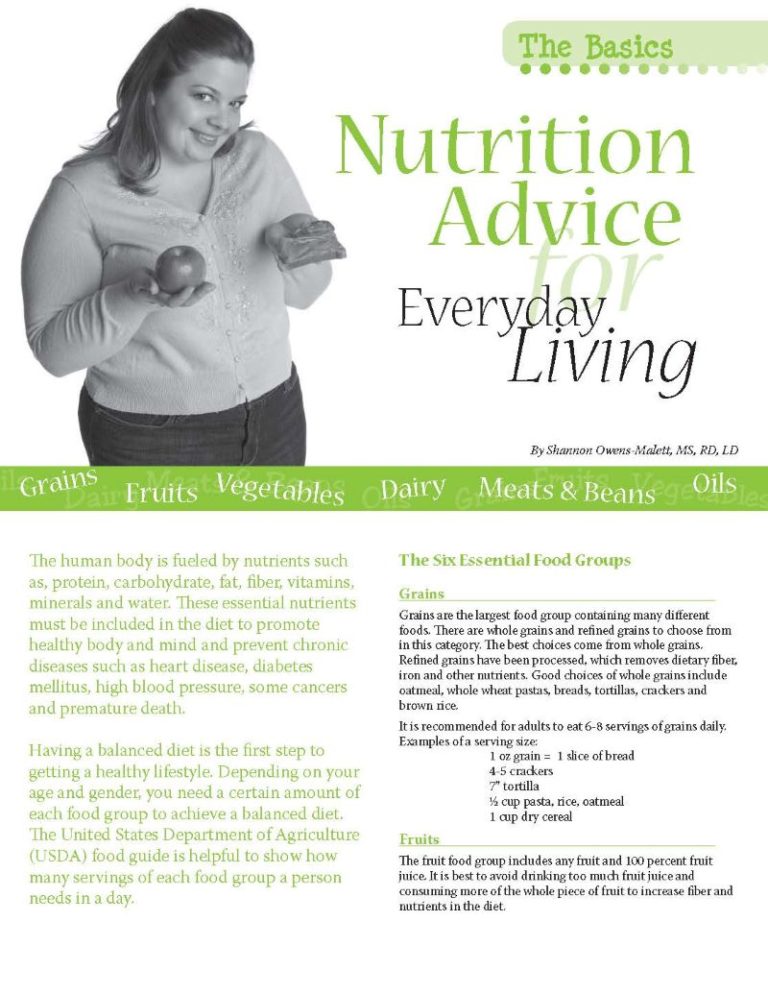Nutrition Advice for Everyday Living


by Shannon Owens-Malett, MS, RD, LD
Spring 2009
The human body is fueled by nutrients such as, protein, carbohydrate, fat, fiber, vitamins, minerals and water. These essential nutrients must be included in the diet to promote healthy body and mind and prevent chronic diseases such as heart disease, diabetes mellitus, high blood pressure, some cancers and premature death.
Having a balanced diet is the first step to getting a healthy lifestyle. Depending on your age and gender, you need a certain amount of each food group to achieve a balanced diet. The United States Department of Agriculture (USDA) food guide is helpful to show how many servings of each food group a person needs in a day.
The Six Essential Food Groups
Grains
Grains are the largest food group containing many different foods. There are whole grains and refined grains to choose from in this category. The best choices come from whole grains. Refined grains have been processed, which removes dietary fiber, iron and other nutrients. Good choices of whole grains include oatmeal, whole wheat pastas, breads, tortillas, crackers and brown rice.
It is recommended for adults to eat 6-8 servings of grains daily. Examples of a serving size:
1 oz grain = 1 slice of bread
4-5 crackers
7” tortilla
½ cup pasta, rice, oatmeal
1 cup dry cereal
Fruits
The fruit food group includes any fruit and 100 percent fruit juice. It is best to avoid drinking too much fruit juice and consuming more of the whole piece of fruit to increase fiber and nutrients in the diet.
Adults should have 2 cups of fruit each day.
Examples of a serving size:
1 cup of fruit:
1 cup fresh, frozen or canned
1 cup 100 percent fruit juice
½ cup dried fruit
Vegetables
The vegetable food group contains any vegetable or 100 percent vegetable juice. This group is broken down into subgroups according to the USDA food guide:
- Dark green vegetables
- Orange vegetables
- Dried beans and peas
- Starchy vegetables
- Other vegetables
The dark green and orange vegetables and dried beans and peas category contain the most nutrition. Adults should include 3 cups of vegetables in their diet. Examples of vegetables:
- Dark green veg. – broccoli, spinach
- Orange veg. – carrots, sweet potato
- Dried beans and peas – cooked black, kidney, pinto beans
- Starchy veg. – potato, corn
- Other veg. – cauliflower, green beans, mushrooms, onions and tomatoes
Examples of a serving size:
1 cup of vegetables:
1 cup raw or cooked fresh, frozen or canned vegetables
1 cup 100 percent vegetable juice
2 cups leafy green vegetables
Dairy
Another food group is milk foods that are high in calcium and most are made from milk. Foods included in this category are:
- All fluid milk
- Lactose-free milk
- Puddings made with milk
- Hard cheeses (cheddar, mozzarella, swiss, parmesan)
- Soft cheeses (ricotta, cottage cheese)
- Processed cheese (American)
- Yogurt
It is best to choose reduced-fat and fat-free milk products. Men and women should have 3 cups from the milk food group.
Examples of a serving size:
1 cup milk or yogurt
1 ½ oz cheese (natural)
2 oz processed cheese
Meats and Beans
Meats and beans are another food group that involves meat, poultry, fish, dried beans/peas, eggs, nuts and seeds. Lean meats should be chosen for a healthy diet. Fish, nuts and seeds contain essential fats and should be included as a balanced diet. It is recommended that adults should consume 6 servings of meats and beans daily.
Examples of a serving size:
1 oz = 1 oz of meat, poultry, pork, fish
¼ cup cooked dried beans
1 egg
1 tbsp peanut butter
½ oz nuts or seeds
Oils
Oils are the final food group and include fats/oils and other foods, such as:
- Nuts
- Olives
- Avocados
- Mayonnaise
- Salad dressing
- Soft margarine
There are healthy types of oil that are good to include in the diet in small amounts. These healthy fats are mono and polyunsaturated oils because they are low in saturated fat. Unhealthy fats are coconut oil, palm oil and solid fats at room temperature such as butter, shortening and lard because they are high in saturated fat.
Another aspect of fat is trans fats, which are produced in foods that contain fats that were once liquid at room temperature and made solid or more saturated through food processing. It is important to choose foods that have no trans fats. The healthiest types of oil/fat include canola, olive, safflower, cottonseed, corn and sunflower oils, as well as nuts, olives and avocados. Reduced-fat margarine, salad dressing or mayonnaise with no trans fat can be a healthier choice.
This food group should be used in small amounts and limited to 6 servings daily.
Examples of a serving size:
1 tsp oil
1 tsp margarine, mayonnaise
1 tbsp reduced-fat margarine or mayonnaise with no trans fat
1 tbsp salad dressing, cream cheese
2 tbsp reduced-fat salad dressing, cream cheese
1/8 avocado
1-2 tsp (1/2 oz) most nuts
2 tsp peanut butter
Tips for Healthy Eating
- Ignore fad diets that recommend cutting out an entire food group.
- Stop eating when feelings of fullness occur.
- Eat slowly.
- Drink plenty of calorie-free beverages.
- Get plenty of fiber from fresh fruits, vegetables and high fiber starches.
- Keep healthy food choices around and get rid of unhealthy food choices.
- Limit simple sugars, high fat foods and alcoholic beverages.
- Eat only ½ of the portion served at restaurants.
- Make a shopping list of healthy foods before traveling to the grocery store and stick with the list.
A healthy diet should incorporate variety and be thought of as a lifestyle rather than a temporary change. Make foods interesting by trying different spices, salsas or modifying a favorite recipe to make it healthier. Changing to a healthy lifestyle does not have to happen quickly. It is okay to take small steps and gradually change as long as the changes happen.
Conclusion
A healthy diet should include at least three to four meals or six small meals each day. A day should begin with a healthy breakfast in order to practice good habits for a balanced diet. Including a good lunch is essential to have energy to stay alert. A healthy dinner is necessary to establish as a routine for your lifestyle and for your family. Snacks can be helpful to satisfy hunger and increase the nutrients consumed each day.
With busy schedules, it may seem like there’s no time to eat healthy. Meal planning is very important and can prevent you from skipping meals, which causes fatigue and overeating at the next meal or snack.
About the Author:
Shannon Owens-Malett, MS, RD, LD, has been a dietitian since 2001 and works at Texas Tech University Student Wellness Center and Advanced Bariatric Surgery Center. She has authored several books and is also active in developing weight-loss surgery dietary curriculum for Texas Tech University.
by Sarah Muntel, RD Spring 2024 Spring has sprung, bringing sunnier and warmer days! For many, this…
Read Articleby Nina Crowley, PhD, RD (with Inspiration from Shawn Cochran) Winter 2024 Dating, no matter your age,…
Read ArticleWith the holidays behind us and 2022 now here, many of us are ready to tackle our…
View Video










